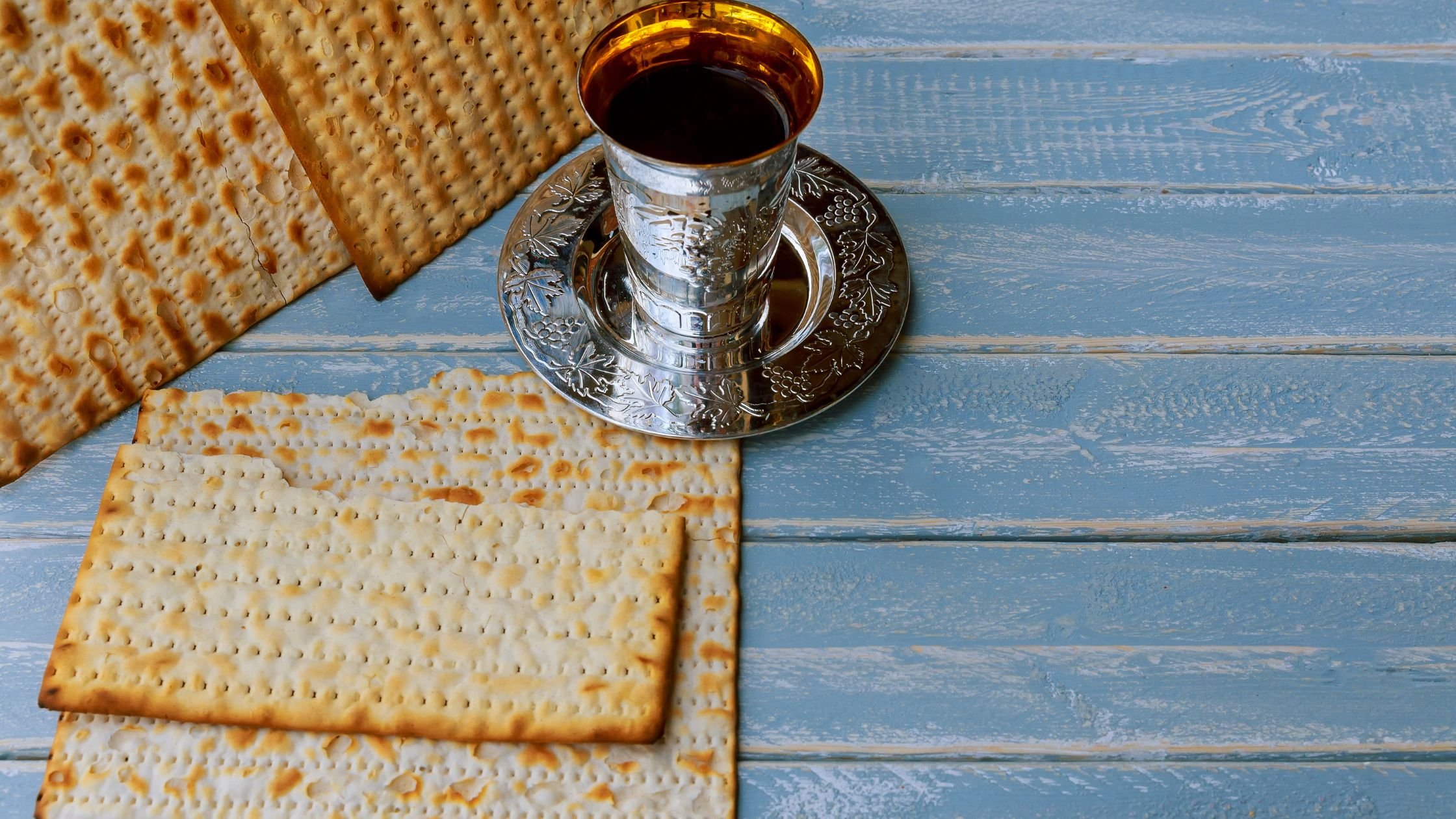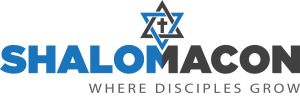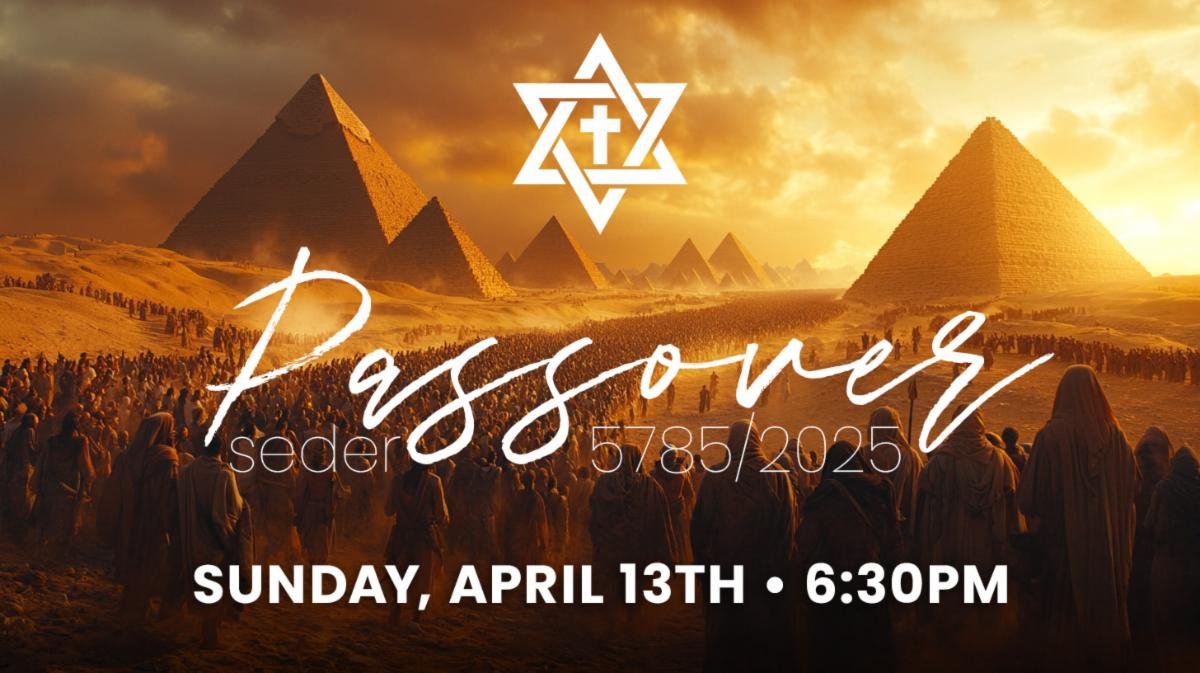
פסח
Passover Seder at Shalom Macon
All available RSVP’s have been reserved for the 2025 seder. Please join us for the next event!
Passover at Shalom Macon is a meaningful celebration centered on redemption—a cornerstone of our faith as followers of Messiah Yeshua. Join us on Sunday, April 13th at 6:30 PM (the second night of Passover), as we retell the powerful story of Israel's deliverance from Egyptian bondage, and reflect on the deeper redemption we experience through Messiah.
Why attend a seder? Passover connects us directly to the roots of our faith and Yeshua’s own observance of this important feast. At Shalom Macon, our seder emphasizes the remarkable parallels between the redemption from Egypt and the redemption accomplished through Yeshua, helping us better appreciate the fullness of God's redemptive plan.
Shalom Macon warmly welcomes everyone to this special evening. We provide all seder essentials, including wine, juice, matzah, and each symbolic element of the seder plate. The seder meal features matzah ball soup, brisket, roasted vegetables, potatoes, and dessert.
Whether you're attending your first seder or enjoying a familiar tradition, join us as we celebrate the timeless story of redemption together.
Adults (13+): $20
Kids (4-12): $10
3 and younger: Free
Household Max: $80
REGISTRATION CUT-OFF IS APRIL 2
A Passover Problem
A “holiday” based on remembering you were a slave? When you really think about it, it’s kind of strange, right? And the Torah has dozens of verses commanding Israel to remember their slavery? Shouldn’t that be something to forget?! Is this the best origin story Israel could have hoped for? There must be more, right? Let’s explore.
Putting it into Practice
Passover is the foundation of all of the biblical festivals, the moment when the Children of Israel were redeemed and became a nation. But how do we commemorate and celebrate it? What about those of us who are Gentiles? Should we have a seder? And if so, what should it look like?
Enjoy the recordings from our previous Passover Lunch & Learn where we learn the biblical background for Passover and how to prepare for it.

A QUESTION OF LEAVEN
WHAT IS IT AND WHAT IS IT NOT?
Author’s note: This article should be considered merely informative and not halachic (legal) in nature. If you have any questions regarding specific food items, you should contact a halachic authority for a definitive ruling.
This English translation of our passage appears fairly straight forward. It seems that we need to get rid of anything that can act as a leavening agent. In fact, some translations even go so far as to insert the word “yeast,” in this passage rather than “leaven.” For most people, this means simply discarding any kind of yeast, baking soda, baking powder, etc. or anything that has been made with them. But is this really what the Torah instructs us?
An immediate question arises that involves a nagging problem that I could not figure out when I first began observing Passover: How can wine be permitted during Passover since wine is made from grapes that are fermented —with yeast? How could Yeshua and his disciples have had wine at their Last Seder? It’s only when I looked at the Hebrew terms behind this passage, that my understanding deepened. Let’s take a look together to discover the truth about this mystery.
Everyone knows that the Torah forbids the Children of Israel from eating leaven during the week of Passover. However, few people have ever studied the terminology to understand what exactly is forbidden and what is permitted during this time. Every year people ask, “What do I need to get rid of for Passover?” They ask about pasta, tortillas, crackers, corn chips, and more. They want to know about baking soda, baking powder, nutritional yeast, yeast extract, etc. Is this going overboard? Not at all. However, there is much confusion and misinformation in this area, and hopefully, this article can shed some light on all of the confusion and bring clarity to this topic. The goal is to have a Passover that is free of confusion. And with God’s help, we will work towards this end. First, let’s look at the biblical commandment for Passover and the week of Unleavened Bread:
Seven days you shall eat unleavened bread. On the first day you shall remove leaven out of your houses, for if anyone eats what is leavened, from the first day until the seventh day, that person shall be cut off from Israel. (Exodus 12:15)
Three Hebrew Words
If we insert the original Hebrew terms back into our passage from above we will see three key words that we need to become familiar with:
Seven days you shall eat matzot ( תוצמ ). On the first day you shall remove se’or ( ראש ) out of your houses, for if anyone eats chametz ( ץמח ), from the first day until the seventh day, that person shall be cut off from Israel. (Exodus 12:15)
The key words in this passage are matzot (singular: matzah), se’or, and chametz. Understanding these three words is critical to our ability to grasp the full meaning of this passage and its implications. From these three distinct words in this single verse we can understand three different instructions from the Torah:
1. We are to eat matzah for seven days.
2. We are to remove all se’or from our homes prior to Passover.
3. We are not to eat chametz for seven days.
The Torah forbids the eating of chametz (ץמח) on Passover and during the week of Unleavened Bread. Is this yeast? The Torah also forbids se’or (ראש) to be found within the homes of the Children of Israel as well. If so, then what is the difference between chametz and se’or?
To further our understanding, we need to explore each of these terms and see how they play into our understanding of each of these instructions from the Torah. And in order to understand this, we must first understand the bread making process from ancient times until now. Let’s take a brief look at this fascinating process.
A Brief History of Bread Making
Before the Middle Ages, bread was made entirely different than most breads today. Up until that time, bread made in the ancient world was what we could consider sourdough. Generally, in order to make bread rise, a person needed to have a sourdough starter on hand and add some of this into her dough. A sourdough starter is created with three ingredients: flour, water, and time. It is made simply by mixing flour and water and allowing it enough time to start fermenting. After a while, the starch in the flour begins to break down and become a host for a culture of naturally occurring yeasts and bacteria. The general rule is that it only takes 18 minutes for the process to begin. These microorganisms will then produce enough gas, in the form of carbon dioxide, in order to sufficiently leaven and flavor bread. Each time a person used some of the sourdough starter, she would add back a little flour and water into the starter in order to keep the fermentation process going, so that the starter would remain active. One thing we need to keep in mind is that although the sourdough mixture contains yeast, it is not yeast itself; it was simply made from flour and water. This will become important in our discussion shortly.
Today, most breads are made with active dry yeast, but it wasn’t until World War II that active dry yeast became available. During the war, Fleischmann’s developed a granulated active dry yeast for the U.S. armed forces that didn’t require refrigeration, and this type of yeast has become the standard for bread making until today. But let’s explore how bread was made up to this point.
The transformation of our baking culture from a sourdough culture to an active dry yeast one was a slow process that took place over many centuries. It began the transformation in the Middle Ages when European bread makers began using the barm (foam) leftover from the beer-making process to assist their bread-making. It generally produced bread that was more sweet than sour (when it turned out right) and thus became very popular. It wasn’t until the turn of the nineteenth century that yeast slurries were created that provided dense concentrations of yeast to be added to bread dough. With technological developments, compressed yeast eventually developed, and a wet yeast cake became the standard for the baking industry in the Western world during the 20th century. Yeast cakes are still available today and used in some industries.
Now that we have a basic understanding of the history of bread making we can begin to understand the various terms that the Torah uses to describe the various instructions for Chag HaMatzot (The Festival of Unleavened Bread). But as we begin understanding these terms as they apply to Passover, we must realize that they only apply to the five grains that appear in the Torah: wheat, barley, oats, rye, and spelt. An easy mnemonic for remembering these five grains is the word [eye]BROWS: Barley / Rye / Oats / Wheat / Spelt.
Although other grains may go through the same processes as described here, they do not have the same status as those found within the Torah. Only these five grains mentioned here are in consideration when we speak of what is permissible or impermissible for the week of Chag HaMatzot. Now, we will take a look at each of these three terms beginning with se’or, because it is the most basic
Se’or
Our central passage instructs, “On the first day you shall remove se’or out of your houses'' (Exodus 12:15). If we are supposed to remove all of the se’or from our homes, then we need to understand what it is. Since there is no explanation of se’or within the commandment, or any other portion of the biblical text for that matter, then it must be assumed that the Israelites coming out of Egypt would have understood this term without the need for any further clarification. It is only in our modern context that terms like se’or and chametz have been lost.
Although a few translations render se’or as yeast, almost all English translations render it as leaven. If we recall what we learned about bread making in ancient times we know that yeast is not an appropriate definition because yeast as an isolated baking ingredient did not exist until the modern era. A pinch of sourdough or a sourdough slurry was the principal ingredient added to a fresh batch of dough in order to begin the fermentation process that would produce enough gas in order to allow bread to rise.
In the passage we are examining, se’or is this sourdough starter. It is a combination of water and flour made from one of the five biblical grains that had been cultured long enough to contain live bacteria that had the ability to work its way into a batch of dough. The Apostolic Scriptures use the Greek equivalent to se’or (ζύμη) to describe this same process. Here are a few examples:
It is like leaven (ζύμη) that a woman took and hid in three measures of flour, until it was all leavened. (Luke 13:21)
Your boasting is not good. Do you not know that a little leaven (ζύμη) leavens the whole lump? (1 Corinthians 5:6)
And he cautioned them, saying, “Watch out; beware of the leaven (ζύμη) of the Pharisees and the leaven of Herod. (Mark 8:15)
As we can see in these instances, “leaven” is something that has the potential to affect what it comes in contact with. In the minds of anyone in the ancient world this referred to a sourdough starter that was added to dough in order to make it rise.
Chametz
If se’or is a fermented mixture of water and flour, then what is chametz? Chametz is basically food that contains se’or. Whereas se’or is the agent that introduces fermentation, chametz is what the se’or acts on. When se’or is added to a batch of dough or other foods, the result is chametz. Therefore, any kind of food product that contains one of the five grains that has had any water added for 18 minutes or longer before being cooked or baked is considered chametz.
Items that would potentially be considered chametz would be too extensive to list. However, a short list of chametz includes: cakes, cookies, pastas, breads, crackers, tortillas, pita chips, beer, and other alcoholic beverages made from distilled grains (bourbon, Irish whisky, Scotch, some brands of vodka). Our list also contains foods that include malt as an ingredient: malt vinegar, malted milk balls, malted drinks, etc. (malt is made from sprouted grain). We can also include anything that is battered such as onion rings, fried cheese, fried fish and other fried foods. Even things that are not obvious such as pre-milled flour (because grain is often sprayed with water and allowed to soak before milling), sprouted grains, bouillon cubes, some candies, certain chips, some (breaded) french fries, etc. could be considered chametz because they may contain grain products and water as added ingredients.
Another consideration is vinegar. The Hebrew word for vinegar is chometz, which is obviously from the same root as chametz. This is because vinegar is made through fermentation. And since vinegar can be made from a number of food sources, including wine, fruits, and grains, most authorities agree that vinegar and products made from vinegar (ketchup, mustard, salsas, salad dressings, etc.) should be discarded for Passover.
As we can see, our topic has quickly become extensive and complicated. In short, any food product that contains a mixture of grains and water outside of matzah specifically made to be kosher for Passover is essentially chametz.
Matzah
Matzah that is kosher for Passover, however, is made with only two ingredients (flour and water) and must be cooked within 18 minutes of the water coming in contact with the flour so that there is no opportunity for fermentation to begin. There is also a stringent process by which the equipment, counters, etc. are all constantly cleaned to ensure there is no residual flour or dough from previous batches that could begin to ferment and then become mixed with new batches of dough. Matzah made from grains other than the five biblical grains are not to be used for Passover because they do not technically qualify as being matzah, especially in order to fulfill a biblical commandment.
Other Concerns
Lastly, items like active dry yeast, nutritional yeast, yeast extract, baking soda, and baking powder are generally of no concern since they are not produced by combining flour and water. However, if there is any doubt, it is better to get rid of it and be wrong than to keep it and be wrong.
There are also considerations to take into account of Ashkenazi observance over Sephardic observance. According to Ashkenazi tradition, wheat-like food items such as rice, corn, lentils, soybeans, peas, etc. are classified as kitniyot (“legumes”) and fall under the same classification as the biblical grains during Chag HaMatzot. Therefore, the definition of chametz is extended in Ashkenazi traditions to include these items as well.
Download the Passover Special edition of our Macon ConneXions newsletter for more Passover fun!
Passover Begins with Shame
Passover is a season of joy, a celebration of the redemption of the people of Israel. Yet the Mishnah says we should begin telling the story with the “disgrace“ of it. This seems odd. But there’s actually a powerful reason for it, especially applicable to disciples of Yeshua. Join us for this discussion.
The Crucifixion Contradiction
Have you ever wondered whether Jesus (Yeshua) was truly crucified on Passover? The Synoptic Gospels (Matthew, Mark, and Luke) and the Gospel of John seem to tell different stories.
In this video, we break down the details of these timelines, explain why these differences matter, and offer a possible reconciliation. Understanding this helps strengthen your knowledge and faith, especially during Passover and Holy Week.







